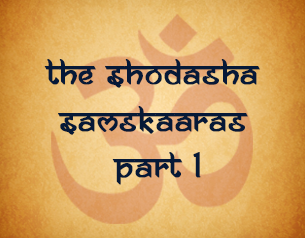
The Shodasha Samskaaras - Part 1
Hinduism believed in the sanctity of one’s life and held that there is a supreme purpose in each person’s life. Hence at every important stage of human life, there were certain rites that were performed. These rites were called ‘Samskaaras’ i.e. the rites to “refine one’s life”. There are sixteen such Samskaaras ordained by the Dharmashastras.
Some of the important Samskaras are:
Garbhadaana
This is the rite performed for safe conception by women. It is believed that procreation was not just a biological or psychological need of a man and woman, but it was a holy communion for the welfare of mankind. Keeping this factor in mind, Garbhadaana is performed as a Samskara rather than as an act of appeasement of carnal pleasure. It is similar to the fertility rites in many other communities.
Pumsavana
This rite is to be performed only for the first child. This is normally performed during the second month of pregnancy i.e. before the sex-determination of the foetus, to ensure a male progeny. Hinduism being a patriarchal society, the son played a great role to ensure the after-life ceremonies of the parents. This in no way undermines a female child, but it is believed that by administering certain potions made of herbs, and due to the efficacy of the mantras, the progeny would be a male.
Seemantonnayana
This is prescribed during 3 rd or 4 the month of pregnancy. The hair of the ‘mother’ is parted at the middle with a porcupine needle with the uttering of certain mantras, praying to Lord Surya to ensure the healthy development of the foetus. The sun rays are said to be containing life-giving energy that would ensure the development of a healthy foetus.
In the present-day scenario, due to misconceptions, the Seemantonnayana is performed only during the seventh or eighth month of pregnancy accompanied by
Pushpakankanadhaarana. It is called ‘Valaikaappu’ by native Tamilians which is not a Vaidika Samskara, but no doubt has a good reason to be followed. According to the modern medical evaluation, the foetus starts to hear the external sounds in the third trimester, so as to ensure that the foetus hears pleasant sounds, the ‘mother’ is anointed with many glass bangles by the household or by the neighbourhood womenfolk. The foetus constantly listens to the chimes of the bangles. Even otherwise, the sounds of the bangles would indicate the location of the expectant ‘mother’ thereby ensuring her safety within the premises of the house.
Jaatakarma
This is a neo-natal rite performed as soon as the child is born. The Dharmashastras recommend the performance within the labour room itself. Presently, as a matter of custom, the said rite is performed on the tenth day after the birth of the child.
